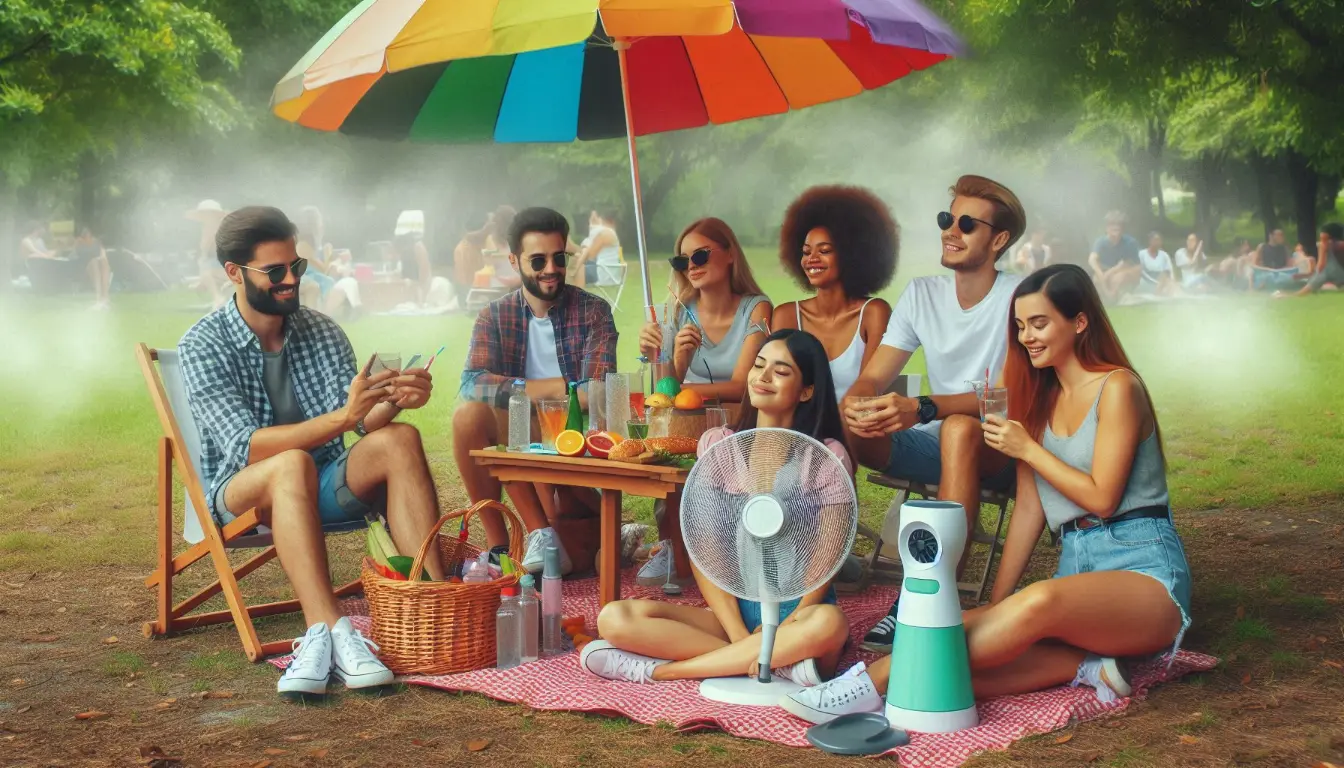Did you know that some outdoor cooling systems can make you feel up to 20°F cooler without actually changing the air temperature? It’s true! These clever devices use the power of physics to trick your body into feeling cool, even on the hottest days.
In this guide, we’ll uncover the secrets behind these modern marvels and explore how they keep us comfortable when the mercury rises. Whether you’re looking to upgrade your backyard or create a cool oasis for your business, understanding the science behind outdoor cooling is your first step to beating the heat.
Key Takeaways
Discover the basic principles of heat transfer that make cooling possible
Learn how different cooling technologies use these principles in clever ways
Explore the pros and cons of various outdoor cooling methods
Understand how environmental factors affect cooling efficiency
Get a sneak peek at the latest innovations in outdoor cooling technology
The ABCs of Keeping Cool: Heat Transfer Basics
Before we dive into specific cooling solutions, let’s talk about how heat moves around. This is the foundation of all cooling technologies, from a simple fan to a high-tech misting system.
Three Ways Heat Likes to Travel
Conduction: When heat moves through solid objects (like when a hot pan heats up its handle)
Convection: Heat traveling through liquids or gases (think hot air rising)
Radiation: Heat zapping through space as waves (like the warmth you feel from the sun)
Outdoor cooling systems mainly focus on convection and a special process called evaporation to create a cooling effect.
The Cooling Power of Evaporation
Evaporation is nature’s way of cooling things down. When water turns from liquid to gas, it absorbs heat from its surroundings. This is the same trick your body uses when you sweat!
“Understanding evaporative cooling is like having a superpower in hot climates. It’s nature’s air conditioning, and we’ve found ingenious ways to harness it.” – Dr. Emily Chen, Environmental Engineer
Misting Systems: Your Personal Cool Cloud
Misting systems are super popular for outdoor cooling, especially in dry areas. But how do they work their magic?
The Misting Magic Trick
Tiny Droplets: Water is forced through super small nozzles, creating a fine mist.
Quick Evaporation: These tiny water droplets evaporate fast, stealing heat from the air.
Cool Zone: The air around the mist gets cooler, creating a refreshing microclimate.
What Makes Misting Work Better?
Droplet Size: Smaller droplets evaporate faster, cooling better.
Air Temperature and Humidity: Misting works best when it’s hot and dry.
Air Movement: A gentle breeze helps spread the cool air around.
A misting system creating a cool microclimate in an outdoor seating area
Evaporative Coolers: Nature’s Air Conditioner
Evaporative coolers, also called swamp coolers, take the idea of evaporative cooling to the next level.
How Evaporative Coolers Do Their Thing
Suck in Hot Air: A fan pulls in warm, dry air.
Wet and Wild: The air passes through wet pads.
Cooldown: As the air moves through, water evaporates and cools the air.
Chill Out: The now-cooler air is blown into your space.
Evaporative Coolers vs. Traditional AC: The Showdown
| Feature | Evaporative Cooler | Traditional AC |
| How It Cools | Evaporation | Refrigeration |
| Energy Use | Low | Higher |
| Effect on Humidity | Adds Moisture | Removes Moisture |
| Maintenance | Simple | More Complex |
| Initial Cost | Lower | Higher |
| Running Cost | Lower | Higher |
| Best Climate | Hot and Dry | Any |
Fans: The Breeze Makers
While fans don’t actually lower air temperature, they can make you feel a lot cooler through the wind chill effect.
Types of Outdoor Fans
Ceiling Fans: Great for covered patios
Pedestal Fans: Easy to move around
Misting Fans: Combine air movement with cooling mist
Big Industrial Fans: For large spaces like warehouses or outdoor events
How Fans Make You Feel Cooler
Fans work by:
Helping sweat evaporate faster from your skin
Blowing away the warm air that builds up around your body
Increasing heat loss from your skin
This doesn’t actually cool the air, but it can make you feel 4-8°F cooler!
Strategic placement of outdoor fans for optimal cooling
Smart Cooling: The Future is Here
As technology advances, smart cooling systems are changing the game for outdoor comfort.
Cool Features of Smart Cooling Systems
Smart Sensors: Keep track of temperature, humidity, and how many people are around
Auto-Adjust: Change cooling settings based on conditions
Phone Control: Manage your cooling from your smartphone
Energy Tracking: See how much energy you’re using and save money
Real-World Example: The Smart Plaza
A shopping center in Arizona installed a smart cooling system that uses misting, fans, and shade. The system uses weather data and tracks how many shoppers are there to optimize cooling. The results?
30% less energy used
People stay 25% longer
Summer sales went up by 15%
Conclusion: Choosing Your Cool
Now that you know how outdoor cooling solutions work, you’re ready to pick the best option for your space and climate. Whether you go for the simplicity of fans, the efficiency of evaporative coolers, or the high-tech approach of smart misting systems, there’s a cool solution out there for you.
Remember to think about:
What kind of weather you usually have
How big your outdoor space is
How much you want to spend upfront and on running costs
Any environmental concerns or local rules
By matching the right cooling tech to your specific needs, you can create an outdoor oasis that’s comfortable all summer long. So go ahead, step outside, and enjoy your perfectly chilled outdoor space!
Ready to start cooling down your outdoor area? Contact a local HVAC specialist to find the perfect system for your needs. Stay cool and comfortable!

![7 Surprising Outdoor Cooling Solutions: Ultimate Guide [2024]](https://cdn.grigora.co/projects/9ddcd5c8-c62c-4197-a4a5-98dcb51b83a4/images/2025/9/15/fountain-bellcote-fireboatwhite01q0al.webp)
